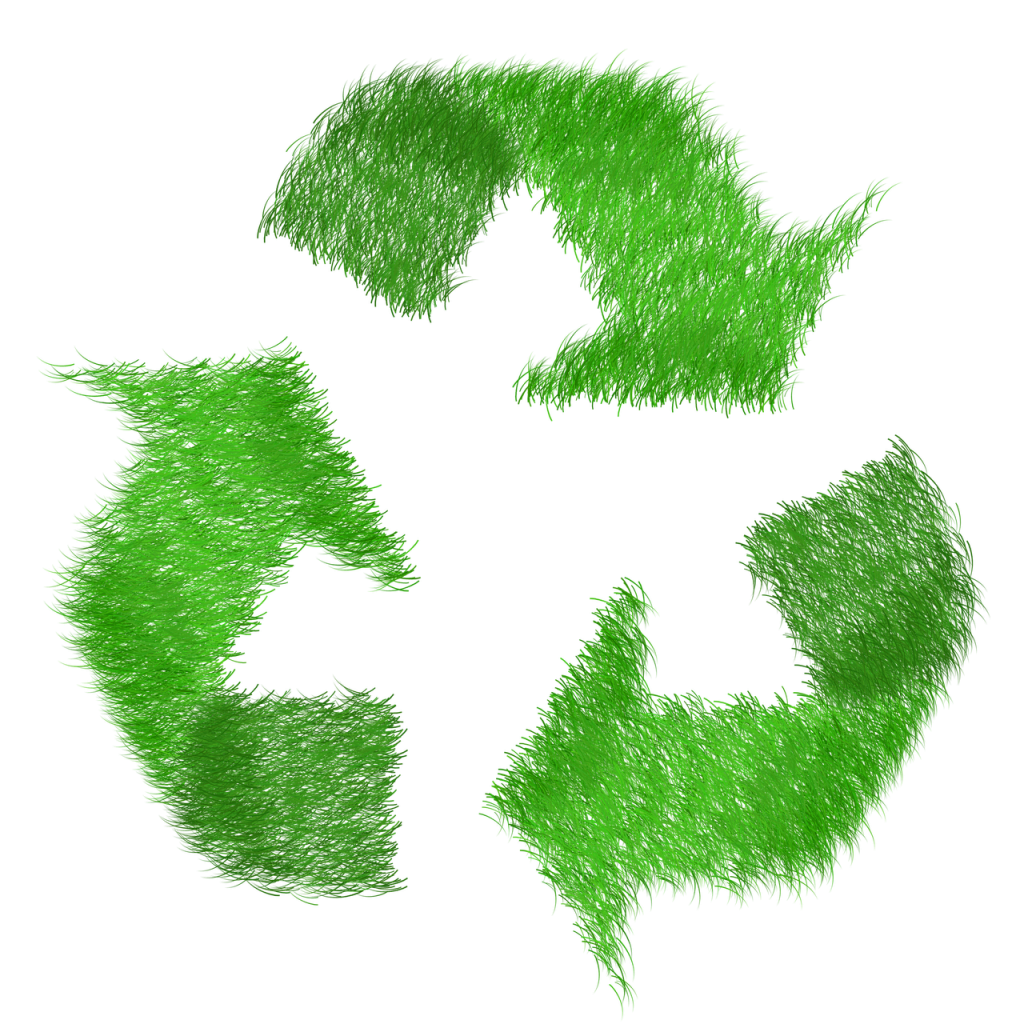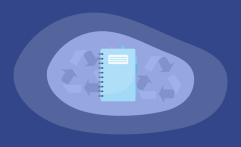Recycling vs. Reusing: What’s the Difference?
Impactful Ninja is reader-supported. When you buy through links on our site, we may earn an affiliate commission.
Learn more
Learn more
.
Hey fellow impactful ninja ? You may have noticed that Impactful Ninja is all about providing helpful information to make a positive impact on the world and society. And that we love to link back to where we found all the information for each of our posts. Most of these links are informational-based for you to check out their primary sources with one click. But some of these links are so-called "affiliate links" to products that we recommend. First and foremost, because we believe that they add value to you. For example, when we wrote a post about the environmental impact of long showers, we came across an EPA recommendation to use WaterSense showerheads. So we linked to where you can find them. Or, for many of our posts, we also link to our favorite books on that topic so that you can get a much more holistic overview than one single blog post could provide. And when there is an affiliate program for these products, we sign up for it. For example, as Amazon Associates, we earn from qualifying purchases. First, and most importantly, we still only recommend products that we believe add value for you. When you buy something through one of our affiliate links, we may earn a small commission - but at no additional costs to you. And when you buy something through a link that is not an affiliate link, we won’t receive any commission but we’ll still be happy to have helped you. When we find products that we believe add value to you and the seller has an affiliate program, we sign up for it. When you buy something through one of our affiliate links, we may earn a small commission (at no extra costs to you). And at this point in time, all money is reinvested in sharing the most helpful content with you. This includes all operating costs for running this site and the content creation itself. You may have noticed by the way Impactful Ninja is operated that money is not the driving factor behind it. It is a passion project of mine and I love to share helpful information with you to make a positive impact on the world and society. However, it's a project in that I invest a lot of time and also quite some money. Eventually, my dream is to one day turn this passion project into my full-time job and provide even more helpful information. But that's still a long time to go. Stay impactful,Affiliate Disclosure
Why do we add these product links?
What do these affiliate links mean for you?
What do these affiliate links mean for us?
What does this mean for me personally?
![]()
Many people recycle and reuse, and many don’t do either. Both are good for the environment, but what exactly is the difference between them?
Recycling is taking old material and converting it into something new while reusing is taking an item you would have normally thrown away and giving it a new purpose. Both aim at eliminating waste and contributing to the continued use of materials.
Many people have heard of recycling and reusing, but the two terms often get intertwined and misused. Whether you are interested in starting to recycle or reuse more or are merely curious about the difference, this article will describe in detail what the difference is between recycling and reusing. Furthermore, it will cover what you can recycle and reuse and why both are good for the environment.
What Are the Differences Between Recycling and Reusing?
Recycling and reusing are two very different things. Recycling is the process of taking an item, dividing it into its individual materials and reprocessing it to create a different material or item. Reusing is when you keep that item intact (more or less) but use it for another purpose. And also when you turn that item into something else (which is called upcycling).
Recycling generally is a three-step-process (collecting & processing, manufacturing, and buying/ selling new products) that relies on several different parties to participate – from the public to the industry. And this process consumes energy. A lot of it. And recycling still produces waste (unlike reusing) in the process from taking material and reprocessing it to create a different material or item.
Reusing, on the other hand, works differently and does not consume the same amount of energy. When you reuse something, you are not throwing away a large amount of material, and you are not wasting energy in dismantling the item. Most of the time, you add new material to it, such as paint or nails, for example. Finally, you are not relying on third parties.
What Is Recycling?
Recycling is when you take materials that would have been thrown in the trash and convert them into new materials for different uses. Many everyday objects that we throw out still have usable material for other things, so recycling takes advantage.
The amount of restored original matter will determine the recyclability of an object. For instance, in a perfect world, each item could be fully recycled. And, for example, office paper would be recycled to become office paper again. But often, some materials have already been modified too much to process and break them down into their original components. This is, for example, why depots cannot convert used office paper into office paper again, but they can turn it into something else like cardboard or newspaper.
How Does Recycling Work?
There are three steps to the whole process of recycling that repeat over and over again. And this is also why the recycling symbol has its three iconic arrows.

And these arrows stand for:
- Collecting and processing
- Manufacturing
- Selling/ buying new products
Recycling Step 1: Collecting and Processing
The first step of the whole process is collecting and processing. There are many different ways to collect materials, such as curbside pickup, refund programs, or recycling drop-off depots.
After the materials are collected, they go to recovery facilities. There are a few things that happen at these facilities. The recyclable materials are sorted and then cleaned. Finally, the depots process them into new materials that can produce different materials and items. After the materials are processed, other corporations and industries buy them to use in the production of their goods.
In the United States, recycled goods go to the Materials Recovery Facility. They are later sent to other facilities to be processed, all depending on what material it is. However, issues can arise at this stage. For the recycled goods to arrive at a facility, somebody has to buy them. If the demand is low, the materials do not get manufactured and are not entered into the recycling loop again.
Recycling Step 2: Manufacturing
During the second step, industries use recycled materials to develop new products. Many different things are made of recycled materials such as newspapers, paper, aluminum, plastic, laundry detergent bottles, steel cans, and soft drink containers. Asphalt can even contain recycled goods.
There are two kinds of manufacturing: downcycling and upcycling. Downcycling is when facilities recycle materials into something that is lower quality than the original item. Upcycling is when facilities process the goods into higher quality items. Downcycling is the main process that facilities do because when something is reused or reprocessed, it loses some of its original value. In other words, it is hard to upcycle items.
Recycling Step 3: New Products That Are Made of Recycled Materials Are Sold and Bought
Finally, the third step is when the products made from recycled materials are sold and bought. For the loop of recycling to continue, consumers have to keep buying the recycled items. There are many items in the store that you can buy that have recycled materials in them. Many items have the following terms on them: recycled-content product, recyclable product, and post-consumer content.
Case Study: How Is Paper Recycled?
To fully understand the process, let’s take a look at a specific example. Paper. Why? Because paper is one of the most frequently recycled materials; let’s see how the process works.
- Used paper is collected and thrown into recycling bins. Many schools and offices have recycling bins around the business. This way, throughout the week, the paper is collected and stored in the bins.
- The public transfers the paper from the small bins to larger bins. Often, there is a large blue recycling bin outside of businesses that collects multiple recyclable materials from many different small bins (from different offices in one building, for instance).
- A truck empties the big blue bins and transfers them to a recycling plant. When the materials reach the plant, they will get sorted. Paper is sorted into different grades and types.
- The facility washes the paper with soap. After the machines sort the paper into certain kinds and grades, the facility washes the paper with soap. This process removes any ink, plastic, staples, or anything else stuck to the paper.
- The facility then mixes the paper with water. The process (called a slurry) removes all of the excess inks and materials on the paper.
- Machines add different materials to the slurry. This mix of paper, water, and other materials can then produce different kinds of paper. The different kinds of paper include office paper, cardboard, and newspaper.
- After the slurry is mixed, it is then spread out into thin sheets using large rollers.
- The slurry dries as the thin sheets. After the paper dries, the depot rolls up the paper into large rolls that are easy to transport. The rolls are then transported by trucks to the businesses that bought the materials. When the material reaches the shops, they cut the material into whatever size they need.
Even though this is only how paper is recycled, the process will be fairly similar across the board. Each material goes through many similar steps to reach its endpoint. And, ass you can imagine, each of these recycling steps take up both time and energy. And this process also keeps these materials out of landfills (as we will discuss later).
What Are the Benefits of Recycling?
Recycling is good for our environment for multiple reasons – even though quite a bit of time and energy is needed in the three-step-recycling-process. The big point? Because it reduces the need for new raw materials. But let’s find out more about that.
Recycling Conserves Natural Resources
Natural resources create many of the artificial materials we use today. The less we recycle, the more natural resources we use, such as timber, minerals, and water. No natural resource is unlimited, and some are lowering in availability.
- When you recycle paper and wood, you are saving trees and forests from extinction. Even though you can replant trees, it is important to conserve ancient forests and rainforests.
- When you recycle plastic, you can save fossil fuels. Simply because fossil fuel hydrocarbons are needed in the process to make (new) plastic.
- When you recycle metal, you are lowering the number of new metal that needs to be produced. Often under dangerous extraction procedures.
Recycling will lower the number of new materials needed. This, in turn, will decrease the amount of processing of materials, which then also lowers the amount of carbon emissions.
Recycling Helps Protect the Ecosystem and Wildlife
Creating artificial materials means taking resources from the natural world. Taking resources from nature often means interrupting natural ecosystems and other harmful acts to nature such as cutting down forests or diverting rivers.
This process often also includes exploiting the most vulnerable and displacing those whose homes are in areas where the resources are to be taken from. For example, those living around forests or river systems.
Recycling Can Save Energy and Costs
One big advantage of recycling over, well, not recycling, is that its both cheaper and more energy efficient:
- Collecting and disposing of waste is a lot more expensive than collecting and processing recycled materials.
- When you make new materials from recycled material, it takes a lot less energy to process them than raw materials. For instance, when you use recycled aluminum to create new products, it takes 95% less energy than if you start from scratch.
Recycling Creates Jobs
Another benefit of recycling to society is that it can create more jobs. As the rate of recycling increases, the jobs related to recycling will increase. We can provide up to 50,000 new jobs when we recycle only 70% of our materials.
What Is Reusing?
Now that we have covered recycling, let’s look at what reusing is and how it differs from recycling.
In short, reusing is about taking an old item and repurposing it. You are not throwing anything away, dismantling anything, or manufacturing it into something new. You are simply taking an object and changing how you use the object.
How Does Reusing Work?
Reusing is when you find different ways to use old objects that you would normally throw away. This can include fixing an item, refurbishing, redecorating, or editing an object in some way to make it better or give it a new purpose.
Reusing Helps Your Items Keep Being Used
One of the most common ways people reuse things is by refurbishing them. Refurbishing an item is when you renovate or redecorate an item.
For example, many people sell their old laptops to electronic stores when they die. The stores then take the computer and ship it to a facility to be fixed. Consumers buy the laptop once the facility fixes it or improves it in some way. Many people buy refurbished phones, laptops, televisions, and several other electronics to save money.
Electronics are not the only items that can be refurbished. Many people will take old couches and furniture and reupholster them or paint them. These solutions are the essence of what reusing an item is – you are not replacing the entire object. You are not changing it into something new; you are fixing it or editing it in such a way that it maintains its original purpose.
Reusing Helps You to Create New Items
However, you do not have to maintain the purpose of an original item to reuse it. Some people take things like old jeans and shirts and turn them into rags. This process takes something old and makes some changes to it to use it for something completely different. And it is also called upcycling.
Upcycling is a form of reusing an item, but for a different purpose. You keep the materials but instead of using them for what they were made for, you use them for something else. You basically turn what you have into something that has a better value for you in the moment.
Let’s go back to our paper recycling example. And have a look at a newspaper this time. After you read what you wanted to, there’s no real need to keep it for its original purpose: reading it. And refurbishing is not an option either because it still functions well. But upcycling is an option. How? You could turn it into a biodegradable flower pot. Or you could even use it to clean your windows!
Either way, upcycling is when you repurpose a product and keep on using it – instead of recycling it. Check out this video for many more upcycling options:
What Are the Benefits of Reusing?
Reusing has many similar benefits as recycling does, such as
- saving money,
- saving energy,
- conserving natural resources,
- decreasing the use of raw materials, and
- preventing the destruction of ecosystems.
Additionally, reusing old items for new purposes can also decrease the amount of waste in landfills.
- More landfills are built as more of them start to fill up. Since landfills are harmful to the environment, it is good to be mindful of slowing down the amount of household waste we produce.
- And landfills have a thing called run-off waste. Run-off waste is when chemical waste from items and materials in the dump leak out and enter the water supply. Landfills also emit methane, which is more harmful to our health and more potent than carbon dioxide is.
When you reuse your items, you also reduce the need for landfills and you reduce landfill run-off waste.
Can Recycling and Reusing Go Together?
Recycling and reusing are two different things that complement each other. The two coincide because you can’t reuse everything, and you also can’t recycle everything – but one may work when the other doesn’t. Think about it like trying to fully use your items until the end of their lifespan. Then try to (let) refurbish or repurpose them. And when your items finally have come to the end of their life, this is when you recycle them.
When you use reusing and recycling sequentially, you are also minimizing your environmental footprint (counting after you got that item).
So, next time before you throw something out, think if there is another way to use that item. Search online for different DIY recipes and ideas. If you cannot reuse the item, then try to recycle it. Finally, only if you cannot recycle it, the trash bin can be your last resort.
Why Are Recycling and Reusing Both Important?
Even though recycling and reusing are two different things, they are both important for different reasons.
- Reusing helps to keep using those items that were produced, either for their original use or for a new one – hence keeping the materials in circulation and reducing the need for new items to be produced.
- Recycling helps create new items with a portion of the materials were already extracted – hence reducing the need to extract more.
Natural resources are limited and the process of extracting them has adverse effects for both environment and society. And then comes throwing them away for good. Reusing and recycling reduces these harmful effects by keeping items longer in circulation and decreasing those adverse effects on both sides.
Final Thoughts
Recycling is taking old material and converting it into something new, while reusing is taking an item you would have normally thrown away and giving it a new purpose. Both have great benefits for the environment and society, including conserving natural resources, protecting wildlife, reducing the use of raw materials, decreasing carbon emissions, saving energy, saving money, and creating jobs.
If you want to learn more about living a more environmentally friendly lifestyle, you might want to check out this book about 101 Ways to Go Zero Waste on Amazon.
Stay impactful,

Sources
- United States Environmental Protection Agency: U.S. Environmental Protection Agency
- United States Environmental Protection Agency: Reduce, Reuse, Recycle
- Rubicon: What Can I Recycle: A Guide to What Makes Something Recyclable
- Insider: 17 Things You Should Never Recycle
- Friends of the Earth: 7 Benefits of Recycling
- Ohio Valley Waste Service: Reduce, Reuse, Recycle
- One Green Planet: 10 Home Items You Can Reuse Over and Over Again
- Community Action Works: Waste
- Wikipedia: Recycling
- Wikipedia: Resin
- Wikipedia: Fossil Fuel
- Wikipedia: Slurry
- Mashable: Recycling in the United States is in serious trouble
- Science How Stuff Works: How recycling works
- Recycling Guide: How Paper is Recycled





